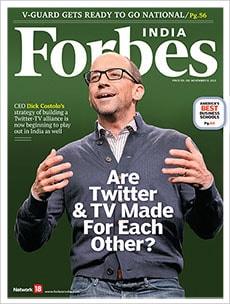Twitter and TV are Feeding Off Each Other in India and Abroad
The trend is visible even in India, and it could soon become a defining partnership


The media and entertainment businesses have never been as seriously impacted as in the last fi ve years, thanks to the digital and social media revolution. It is still print publications and TV which hold pride of place in terms of advertiser perceptions and revenues, but a signifi cant part of the conversation relating to what is written or broadcast in mainstream media happens in the digital space, on platforms such as Twitter, Facebook, YouTube, et al. So much so that it is no longer
clear where mainstream ends and social media take over. Take TV. The best programming still happens here, but the audience often watches the stuff at a time of its own choosing, on YouTube or on other digital platforms. Reality shows like Bigg Boss or the Indian version of The Bachelorette, starring Mallika Sherawat, are most likely watched first on plasma and LED screens in living rooms across India, but a lot of the buzz preceding and following the shows happens on Twitter.
Take TV. The best programming still happens here, but the audience often watches the stuff at a time of its own choosing, on YouTube or on other digital platforms. Reality shows like Bigg Boss or the Indian version of The Bachelorette, starring Mallika Sherawat, are most likely watched first on plasma and LED screens in living rooms across India, but a lot of the buzz preceding and following the shows happens on Twitter.
We still do not know how TV and Twitter and other social media are going to impact one another, but one of the reasons why we put Dick Costolo, CEO of Twitter, on the cover of this issue of Forbes India is simple: The trend is visible even in India, and it could soon become a defining partnership. The Forbes cover story quotes Costolo as saying: “As we’ve grown, it’s become more and more clear to us that the characteristics that make up Twitter—public, real-time and conversational—make it a perfect complement to television. TV has always been social and conversation-driven. It’s just that in the past, the reach of that conversation was limited by the number of people in a room or who you could talk to on the phone or the next day at the watercooler. Broadcasters have come to understand that Twitter is a force multiplier for the media they’ve created.”
In India, as Sohini Mitter tells us in an accompanying story, entertainment shows are trying to use Twitter buzz as a kind of extended marketing tool. With around 20 million Indians addicted to the microblogging site, the betting is that if even 5 percent of them get talking about a TV show, it can measure audience impact better than what many people meters can do. We do not know whether TV and Twitter are merely in a short-term marriage of convenience or a long-term mutual support system. But we do believe it is something worth watching.
Best,
R Jagannathan
Editor-in-Chief, Forbes India
Email: r.jagannathan@network18online.com
Twitter id: @TheJaggi
First Published: Nov 01, 2013, 06:49
Subscribe Now